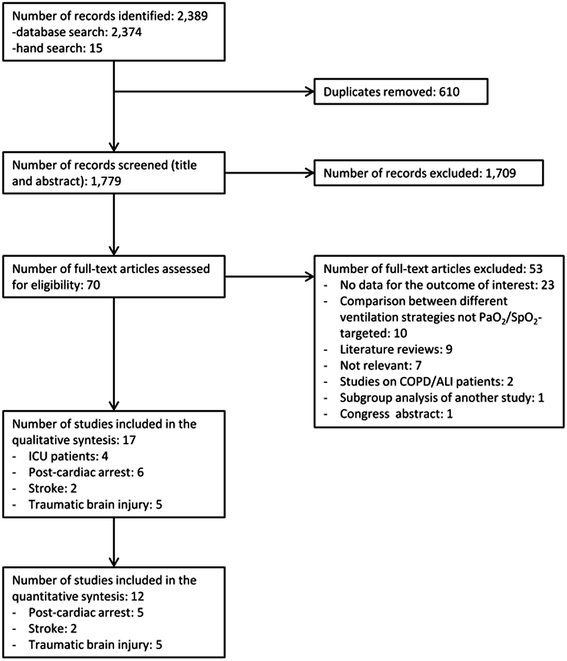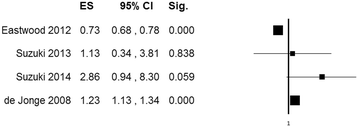Arterial hyperoxia and mortality in critically ill patients: a systematic review and meta-analysis
- PMID: 25532567
- PMCID: PMC4298955
- DOI: 10.1186/s13054-014-0711-x
Arterial hyperoxia and mortality in critically ill patients: a systematic review and meta-analysis
Abstract
Introduction: The safety of arterial hyperoxia is under increasing scrutiny. We performed a systematic review of the literature to determine whether any association exists between arterial hyperoxia and mortality in critically ill patient subsets.
Methods: Medline, Thomson Reuters Web of Science and Scopus databases were searched from inception to June 2014. Observational or interventional studies evaluating the relationship between hyperoxia (defined as a supranormal arterial O2 tension) and mortality in adult intensive care unit (ICU) patients were included. Studies primarily involving patients with exacerbations of chronic pulmonary disease, acute lung injury and perioperative administration were excluded. Adjusted odds ratio (OR) of patients exposed versus those not exposed to hyperoxia were extracted, if available. Alternatively, unadjusted outcome data were recorded. Data on patients, study characteristics and the criteria used for defining hyperoxia exposure were also extracted. Random-effects models were used for quantitative synthesis of the data, with a primary outcome of hospital mortality.
Results: In total 17 studies (16 observational, 1 prospective before-after) were identified in different patient categories: mechanically ventilated ICU (number of studies (k) = 4, number of participants (n) = 189,143), post-cardiac arrest (k = 6, n = 19,144), stroke (k = 2, n = 5,537), and traumatic brain injury (k = 5, n = 7,488). Different criteria were used to define hyperoxia in terms of PaO2 value (first, highest, worst, mean), time of assessment and predetermined cutoffs. Data from studies on ICU patients were not pooled because of extreme heterogeneity (inconsistency (I(2)) 96.73%). Hyperoxia was associated with increased mortality in post-cardiac arrest patients (OR = 1.42 (1.04 to 1.92) I(2) 67.73%) stroke (OR = 1.23 (1.06 to 1.43) I(2) 0%) and traumatic brain injury (OR = 1.41 (1.03 to 1.94) I(2) 64.54%). However, these results are limited by significant heterogeneity between studies.
Conclusions: Hyperoxia may be associated with increased mortality in patients with stroke, traumatic brain injury and those resuscitated from cardiac arrest. However, these results are limited by the high heterogeneity of the included studies.
Figures





References
-
- Task Force for Diagnosis and Treatment of Acute and Chronic Heart Failure 2008 of European Society of Cardiology. Dickstein K, Cohen-Solal A, Filippatos G, McMurray JJ, Ponikowski P, Poole-Wilson PA, Strömberg A, van Veldhuisen DJ, Atar D, Hoes AW, Keren A, Mebazaa A, Nieminen M, Priori SG, Swedberg K, ESC Committee for Practice Guidelines. Vahanian A, Camm J, De Caterina R, Dean V, Dickstein K, Filippatos G, Funck-Brentano C, Hellemans I, Kristensen SD, McGregor K, Sechtem U, Silber S, Tendera M, et al. ESC guidelines for the diagnosis and treatment of acute and chronic heart failure 2008: the task force for the diagnosis and treatment of acute and chronic heart failure 2008 of the European Society of Cardiology. Developed in collaboration with the heart failure association of the ESC (HFA) and endorsed by the European Society of Intensive Care Medicine (ESICM) Eur Heart J. 2008;29:2388–2442. doi: 10.1093/eurheartj/ehn309. - DOI - PubMed
-
- Anderson JL, Adams CD, Antman EM, Bridges CR, Califf RM, Casey DE, Jr, Chavey WE, II, Fesmire FM, Hochman JS, Levin TN, Lincoff AM, Peterson ED, Theroux P, Wenger NK, Wright RS, Smith SC, Jr, Jacobs AK, Adams CD, Anderson JL, Antman EM, Halperin JL, Hunt SA, Krumholz HM, Kushner FG, Lytle BW, Nishimura R, Ornato JP, Page RL, Riegel B, American College of Cardiology. American Heart Association Task Force on Practice Guidelines (Writing Committee to Revise the 2002 Guidelines for the Management of Patients With Unstable Angina/Non-ST-Elevation Myocardial Infarction) American College of Emergency Physicians. Society for Cardiovascular Angiography and Interventions. Society of Thoracic Surgeons. American Association of Cardiovascular and Pulmonary Rehabilitation. Society for Academic Emergency Medicine ACC/AHA 2007 guidelines for the management of patients with unstable angina/non-ST-elevation myocardial infarction: a report of the American College of Cardiology/American Heart Association task force on practice guidelines (writing committee to revise the 2002 guidelines for the management of patients with unstable angina/non-ST-elevation myocardial infarction) developed in collaboration with the American College of Emergency Physicians, the Society for Cardiovascular Angiography and Interventions, and the Society of Thoracic Surgeons endorsed by the American Association of Cardiovascular and Pulmonary Rehabilitation and the Society for Academic Emergency Medicine. J Am Coll Cardiol. 2007;50:e1–e157. doi: 10.1016/j.jacc.2007.02.013. - DOI - PubMed
-
- O’Driscoll R, Davison A, Elliott M, Howard L, Wedzicha J, Mackway-Jones K, Jenkins P, Kishen R, Levy M, Perrott S, Mansfield L, Evans A, Panizzo S, Moore F, Whitmore D, Gibbs S, Martin B, Hinshaw K. BTS guideline for emergency oxygen use in adult patients. Thorax. 2008;63:vi1-68. - PubMed
Publication types
MeSH terms
LinkOut - more resources
Full Text Sources
Other Literature Sources
Medical

